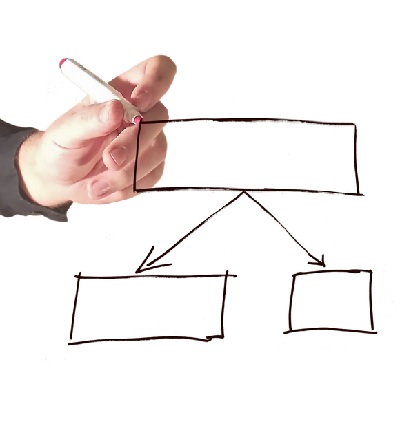Visual modeling
Article#: 00074
Date: 2021-12-04
Author: Radim

Visual modeling is a very useful tool in project analysis and documentation.
It involves creation of standardized diagrams, which we usually make before we start programming, i.e. in the requirements specification and analysis phase.
The main advantage of visual modeling is that it makes orientation in the created program much easier.
We can better perceive the information found in graphical form than when reading text, and most importantly we present the whole complex structure in a diagram so that we always have it available when dealing with details.
We don't show all the information in the diagram as it is an abstraction, it just captures the overall structure, the most basic objects and their relationships.
Therefore, we don't have to update the model every time we change something less important in the code during programming.
The diagrams are excellent for understanding the structure and for quick orientation, but if we try to cram everything, they lose their advantage in terms of clarity.
Above the diagrams we can discuss the architecture and whether our model contains all the necessary functions or whether something has been forgotten.
The model does not replace the documentation, but it serves as a basis for documentation so that everyone can quickly understand the structure of the program.
Be aware that some people will not know the modeling language in detail or will not have the patience to learn it.
For this reason, we shouldn't use advanced modeling constructs that appear as different types of stars, beveled corners, etc., and stick with the basic elements that are displayed intuitively.
Reference:
- Petr Paleta. Computer Press (2003). Co programátory ve škole neučí.
© Radim-Automation, 2020–2025. All rights reserved.
Sharing of this article is permitted with proper attribution (link to the original page).
Related previous articles:
- Choice of programming language
- Machine modularization
- Modular software architecture
- Hardware concept
- A good concept = Complete set of suitable solutions
- Learn from your journey!
- Project leader
- Why do automation projects fail?
- Collect all the requirements and sort them!
- Who will operate?
- Functional and intuitive HMI
- Appoint a representative!
- Set your goals for today, tommorow, this week ...
- HMI and PLC applications should grow together
- Prepare a good project plan and keep it up to date!
- I can see what you can not see
- More than just start and stop
- Safety first!
- Do the right things and do them right!
- Define test scenarios and test cases continuously!
- Don't make it worse!
- Keep the answers to the question "Why"
- Everything is difficult until it becomes easy
- Introduce the terminology and standardize it!
- Realize every good idea ASAP!
- Get and stay in the flow!
- What does the customer need?
- Ask questions!
- Communication skills are extremely important
- Don't replace employees in the middle of the project!
- Focus on target!
- Think on paper!
- Multitasking is harmful
- Avoid overly optimistic estimates!
- Sharpen your axe before you start felling!
- Understand - Agree - Be Identified - Believe
- Check the result!
- Keep it simple!
- Don't leave a work package half-finished!
- Success is not a matter of coincidence
- Choose the right tool!
- Don't neglect and don't skip any step!
- Transparency and reliability
- From an idea to a consistent system
Related next articles:
- Documentation issues
- Talk to operators
- Event logger as the very first function implemented in the program
- My boss was a hero
- Version control system
- PLC network diagram
- Keep the documentation up to date throughout the project
- Maintain order in the program code
- Keep everything you need together
- The false illusion of rapid progress
Comment#: 00001
Date: 2021-12-05
User: Radim
State machine diagram is a useful thing in the program design phase as well as during testing of the program. We just need to test all the states, conditions and transitions that we can see in the state machine diagram.
Comment#: 00002
Date: 2021-12-05
User: Radim
"The UML language is worked out in every detail, its definition comprises around six hundred pages. But there is one advantage - you just need to know a few basic rules to get started. And the diagrams themselves are so intuitive that they can be shown to anyone without hesitation, including a customer who has no idea about software development, everyone can find their way around quickly and knows what it is about."
- Petr Paleta. Computer Press (2003). Co programátory ve škole neučí.
Comment#: 00003
Date: 2021-12-05
User: Radim
"UML is an excellent tool and there are people who claim that modeling in UML is the basis of the development process: The code is generated from the model and its manual completion is no longer a problem... Of course, such an approach is not correct. Diagrams are created mainly during analysis, and we may not yet have enough information to create effective code."
- Petr Paleta. Computer Press (2003). Co programátory ve škole neučí.
Comment#: 00004
Date: 2021-12-05
User: Radim
"UML has some limitations that we would run into if we were to think of this language as the only analysis tool and want to display graphically everything. For example, displaying a list of use cases on a diagram is almost strange. A text-based list would be much shorter and clearer in this case."
- Petr Paleta. Computer Press (2003). Co programátory ve škole neučí.
Comment#: 00005
Date: 2021-12-05
User: Radim
"Just as you would never begin building a house without a blueprint, you should not start coding without a detailed, written design for your program.
If you don’t know the intended outcome of your program, you will waste lots of time writing muddled code that accomplishes no particular objective."
- https://towardsdatascience.com/notes-on-software-construction-from-code-complete-8d2a8a959c69